Services on Demand
Journal
Article
Indicators
-
 Cited by SciELO
Cited by SciELO -
 Access statistics
Access statistics
Related links
-
 Similars in
SciELO
Similars in
SciELO
Share
Journal of the Mexican Chemical Society
Print version ISSN 1870-249X
J. Mex. Chem. Soc vol.57 n.1 Ciudad de México Jan./Mar. 2013
Article
Catalytic Properties of Pure and K+-Doped CuO/MgO System Towards 2-Propanol Conversion
Sahar A. El-Molla,*,1 Gamil A. El-Shobaky,2 Nabil H. Amin,1 Mohamed N. Hammed,1 Sahar N. Sultan1
1 Chemistry Department, Faculty of Education, Ain Shams University, Roxy, Heliopolis, Cairo 11757, Egypt. saharelmolla@yahoo.com
2 National Research Center, Dokki, Cairo, Egypt
Received September 5, 2012.
Accepted March 21, 2013.
Abstract
CuO/MgO system having different compositions was prepared by impregnation method followed by calcination at 400-900 °C. The effect of CuO content, calcination temperature and doping with small amounts of K+ species (1-3 mol %) on physicochemical, surface and catalytic properties of the system were investigated using XRD, adsorption of N2 at −196 °C, and conversion of isopropyl alcohol at 150-400 °C using a flow technique. The results revealed that the solids having the formulae 0.2 and 0.3 CuO/MgO calcined at 400 °C consisted of nanosized MgO and CuO as major phases together with Cu2O as minor phase. The BET-surface areas of different adsorbents are decreased by increasing CuO content, calcination temperature and K+-doping. MgO-support material showed very small catalytic activity in 2-propanol conversion. The investigated system behaved as selective catalyst for dehydrogenation of 2-propanol with selectivity > 80%. The catalytic activity increased by increasing CuO content and decreased by increasing the calcination temperature within 400-900 °C. K+-doping increased the catalytic activity and catalytic durability.
Key words: CuO/MgO, K+-doping, Catalytic Activity, Selectivity, Durability.
Resumen
Se preparó CuO/MgO con diferentes composiciones por el método de impregnación seguido por calcinación a 400-900 °C. El efecto del contenido de CuO, temperatura de calcinación y el dopaje con pequeñas cantidades de K+ (1-3 mol%) en la superficie sobre las propiedades fisicoquímicas y catalíticas del sistema se investigaron mediante DRX, la adsorción de N2 a −196 °C, y la conversión de alcohol isopropílico a 150-400 °C usando una técnica de flujo. Los resultados revelaron que los sólidos que tienen las fórmulas 0,2 y 0,3 CuO / MgO calcinado a 400 °C consisten en partículas nanométricas de MgO y CuO como fases principales junto con Cu2O como fase secundaria. Las áreas superficiales BET se disminuyeron al aumentar el contenido de CuO, temperatura de calcinación y presencia de K+. MgO puro mostró actividad catalítica muy pequeña en la conversión de 2-propanol. El sistema investigado se comportó como un catalizador selectivo para la deshidrogenación de 2-propanol con una selectividad > 80%. La actividad catalítica aumentó con el contenido de CuO y disminuyó al aumentar la temperatura de calcinación en el intervalo de 400-900 °C. Las especies de K+ aumentaron la actividad y la durabilidad catalítica.
Palabras clave: CuO/MgO, K+-doping, actividad catalítica, selectividad, durabilidad.
Introduction
The addition of small amounts of alkali has long been known to modify the activity and the selectivity of heterogeneous catalysts, or to improve their lifetime [1]. Alkali doping of metal surfaces is generally interpreted in terms of electronic effects [2]. The additive is considered as a base, transferring electrons to the metallic phase, thus increasing the adsorption bond strength of the electron-acceptor molecules [2]. The presence of K+ ions modifies the molybdenum oxide structure in supported MoOx [3, 4]. It has been reported that addition of increasing amounts of potassium oxide up to 1.8 wt. % to Cr2O3/γ-Al2O3 system, acting as dehydrogenation catalyst, can modify its surface chemistry and its catalytic behavior [5]. Alkali additives have been used in copper-based catalysts for WGS and RWGS reactions [6, 7]. The addition of potassium to a copper catalyst was also found to be a valid method for promotion of WGS reaction [8]. Doping Cu/SiO2 with potassium promoter in H2 and CO2 reaction increased CO selectivity [9]. The effect of potassium doping on Co/Al2O3 Fischer–Tropsch catalyst has been investigated. Potassium doping stabilizes catalytic activity, reduces methane selectivity and increases CO2 selectivity [10]. The mitigation of surface acidity and tuning of acid strength of niobic acid were successfully obtained by K+, Ba2+, and Nd3+ surface doping. K+ ions doped more selectively the Brønsted acid sites while the Ba2+ and Nd3+ ions doped more selectively the Lewis acid sites of niobic acid [11].
The activity and selectivity of magnesia-supported metal oxides could be improved by treatment with foreign ions. These treatments modify the concentration and the nature of the catalytically active sites of the treated solids. Doping MgO-supported catalysts with alkali metals having larger cationic radius than that of Mg2+ enhanced their catalytic activity in many industrial reactions such as the acrylonitrile synthesis from methanol [12]. Alcohol conversion has been studied using various solids such as copper oxide [13], and copper-thorium oxide [14]. The coexistence of Cu2+, /Cu+ and /or Cu0 in the thoria is required for activity towards dehydrogenation of isopropyl alcohol [14]. The conversion of isopropyl alcohol over solids containing magnesia catalyst has been investigated using a pulse microcatalytic reactor [15] and flow system [16]. The activity depends on the reaction temperature, textural properties, nature and concentration of the dopant added [15]. The present work was devoted to study the surface and catalytic properties of CuO/MgO system as being influenced by doping with small amounts of K2O. The techniques employed were, TGA, DTA, XRD, SBET measurements and catalytic conversion of isopropyl alcohol using a flow method.
Experimental Section
Materials
Five specimens of CuO/MgO were prepared by wet impregnation method. A known mass of MgCO3 was impregnated with solutions containing different proportions of copper nitrate dissolved in the least amounts of distilled water. The obtained solids were dried at 110 °C then calcined at 400-900 °C for 4h. The nominal composition of the calcined solids was x CuO/MgO, where x = 0.025, 0.05, 0.10, 0.20, and 0.30 CuO. The concentration of CuO in these samples was 4.7, 9, 16.4, 28.3, and 37.1 wt %. The solids having the formula 0.2 CuO/MgO were doped with K+ species. The doped samples were prepared by treating a known mass of MgCO3 support material with different amounts of KNO3 dissolved in the least amounts of distilled water dried at 110 °C till constant weight. The K+-treated samples were then impregnated with known amounts of Cu(NO3)2·6H2O dissolved in the least amounts of distilled water sufficient to make paste, dried at 110 °C then calcined in air at 400 °C for 4h. The dopant concentration was1, 2 and 3 mol% which correspond to 1.65, 3.24, and 4.8 wt % K+ species. All the chemicals employed were of analytical grade supplied by BDH Company.
Techniques
Phase analysis of pure and variously K+-doped solids preheated in air at 400 and 800 °C were performed by X-ray powder diffraction employing a BRUKER Axs D8 Advance, Germany. The patterns were run using Ni-filtered copper radiation (λ = 1.5404 Å) at 40 kV and 40 mA. The scanning rate was fixed at 8° and 0.8° in 2θ/min for phase identification and line broadening profile analysis, respectively. The average crystallite size (D) of crystalline phases present was calculated by using the Scherrer equation [17], D = Bλ/B1/2 cos θ where B is the Scherrer constant (0.89), B1/2 the full width at half maximum (FWHM) of the main diffraction peak and θ is the diffraction angle in radian.
The specific surface areas of the pure and variously doped samples were determined from nitrogen adsorption isotherms measured at −196 °C using a Quantachrome NOVA2000 automated gas sorbometer model 7.11. All samples were degassed at 200 °C for 2 hours under a reduced pressure of 10−5 Torr before undertaking such measurements.
The catalytic activities of the various catalyst samples were determined by using conversion of isopropyl alcohol carried out at 150-400 °C, the catalytic reaction was conducted in a flow reactor under atmospheric pressure. Thus, a 50 mg catalyst sample was held between two glass wool plugs in a Pyrex glass reactor tube 20 cm long and 1 cm internal diameter packed with quartz fragments 2-3 mm length. The temperature of the catalyst bed was regulated and controlled to within ±1 °C. Argon gas was used as the diluents and the isopropyl alcohol vapor was introduced into the reactor through an evaporator/saturator containing the liquid reactant at constant temperature (35 °C). The flow rate of the carrier gas was maintained at 25 mL/min. Before carrying out such catalytic activity measurements, each catalyst sample was activated by heating at 350 °C in a current of argon for 2 hours then cooled to the catalytic reaction temperature. The reaction products in the gaseous phase were analyzed chromatographically using Perkin-Elmer Auto System XL Gas Chromatograph fitted with a flame ionization detector. The column used was fused silica glass capillary column type PE-CW length 15 m-1.0 UM Perkin-Elmer Corp. For simplicity, the catalytic activity was expressed as the total conversion of iso-propanol measured at different temperatures. The products selectivities were calculated in terms of the reaction yield of each product at various temperatures divided by total conversion x100.
Results and Discussion
XRD investigation of pure and K+-doped CuO/MgO solids
Effect of extent of CuO loading
X-ray powder diffractograms of 0.1, 0.2, and 0.3 CuO/MgO precalcined at 400 °C were determined and illustrated in Figure 1. It is seen from this figure that, the diffractograms of the solids investigated calcined at 400 °C consist of nanosized-MgO and CuO phases whose degree of crystallinity increases by increasing the extent of CuO present. The crystallite size of CuO phase present in different investigated samples calcined at 400 °C measured 27, 32, and 37 nm for the solids having the compositions 0.1, 0.2, and 0.3 CuO/MgO, respectively. The crystallite size of MgO present in these supported solids was found to measure about 45 nm in various solids investigated. Preliminary experiment showed that the crystallite size of un-loaded CuO phase prepared by thermal decomposition of copper nitrate at 400 °C measured about 150 nm. These results justify the use of MgO as a support material for CuO in order to have finely divided nano crystalline CuO catalyst.
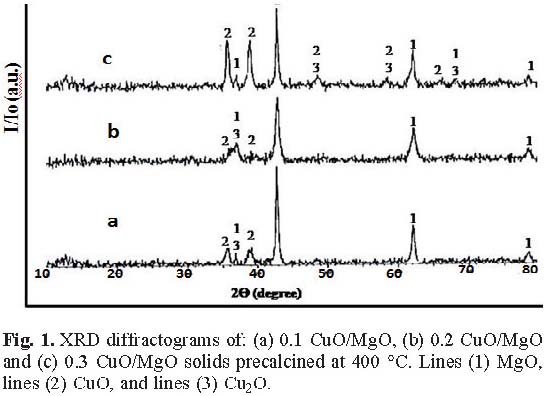
The fact that MgO and Cu2O phases show common diffraction lines at d = 2.43, 2.11 and 1.48 Å makes their distinction a difficult task. However, the brown coloration of the solids having the formulae 0.2 CuO/MgO and 0.3 CuO/MgO and being precalcined at 400 °C, might suggest the possible formation of Cu2O phase together with CuO and MgO phases [18]. XPS is a decisive tool to be used for detecting copper with various oxidation states. However, using the brown coloration as the first evidence, which supports our speculation for the presence of copper with different oxidation, states (Cu+ and Cu+2). An additional evidence comes from the significant increase in the relative intensity of the diffraction peak at d = 2.43 Å which corresponds to 10% in case of MgO increased to 30% in case of (0.2 CuO/MgO) solid calcined at 400 °C due to a possible superposition with the main line of Cu2O found at the same d-value [18].
The presence of zero-, mono-, and divalent copper cations in CuO lattice especially when it is loaded on MgO support material had been reported [18-21]. So, the possible presence of Cu2O in our case is suggested from the brown coloration acquired by 0.2 and 0.3 CuO/MgO solid calcined at 400 °C and also from results previously published [18].
Effect of calcination temperature and K+-doping
X-ray diffractograms of 0.1 CuO/MgO calcined at 400 and 800 °C are illustrated in Figure 2. This figure shows that the increase in the calcination temperature from 400 to 800 °C increases the degree of crystallinity of both CuO and MgO phases as being evidenced from the effective increase in the peak area of their main diffraction lines, from 20.5 to 44.6 (a.u.) of CuO and from 164 to 262 (a.u.) relative to MgO phase. The crystallite size of CuO increases from 24.5 to 83 nm while the increase of crystallite size was so limited in case of MgO from 46 to 49.4 nm.
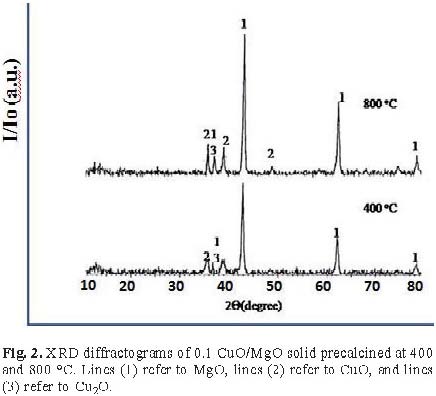
Figure 3 shows the diffractograms of pure and doped 0.2 CuO/MgO solid sample with 3 mol % K+- samples calcined at 400 °C. It is seen from this figure that the x-ray diffractograms consist of CuO and MgO phases with moderate degree of crystallinity. Doping with 3 mol % K+ increased slightly the degree of ordering of MgO phase.
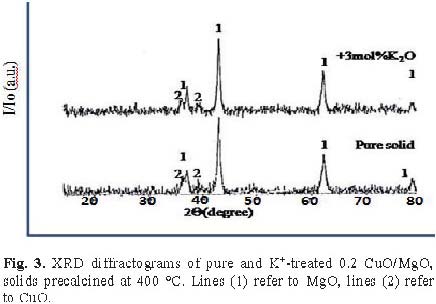
Specific surface areas of different investigated solids
The SBET of CuO/MgO system having different compositions and being calcined at 400 °C and 800 °C were determined from N2 adsorption measurements carried out at −196 °C. The BET-surface area of 0.2 CuO/MgO doped with 1 and 3 mol% K+ and being calcined at 400 °C were also determined. The results obtained are given in Table 1. It is seen from this table that the increase in CuO content from 0.1 to 0.2 mol CuO/mol catalyst calcined at 400 °C brought about a limited decrease in the specific surface area of the investigated adsorbents. However, K+-doping (3 mol %) and increasing the calcination temperature from 400 to 800 °C resulted in a measurable decrease in the SBET of treated adsorbents.
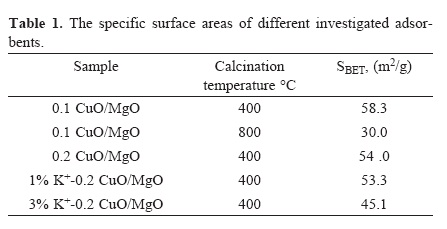
Catalytic activity measurements of different investigated solids
Effect of extent of CuO loading on the activity CuO/MgO system towards 2-propanol conversion
The catalytic conversion of isopropyl alcohol was carried out over 0.025, 0.05, 0.1, 0.2, and 0.3 CuO/MgO solids calcined at various temperatures, where the reaction time at each temperature does not exceed than 10 min. The catalytic reaction was also carried out over MgO support material calcined at 400 °C. Moreover, the reaction was carried out over unloaded CuO obtained from the thermal decomposition of copper nitrate in air at 400 °C. Figure 4 shows the effect of extent of CuO loading on the % conversion as a function of reaction temperature. It is noticed from Figure 4 that: (i) MgO and un-supported CuO exhibited small catalytic activities. The activity of CuO was, however, greater than that of MgO. This finding clarifies the necessity of using a support for increasing the catalytic activity of copper oxide. (ii) The presence of the smallest amount of CuO (0.025 mol/mol catalyst) led to an effective increase in the catalytic activity, expressed as total conversion at various temperatures. (iii) The increase of CuO content above this limit within 0.05-0.3 mol/mol catalyst brought about a limited increase in the catalytic activity of the investigated system. (iv) There is a linear increase in total conversion as a function of reaction temperature from 150 to 400 °C in case of individual CuO or MgO solids, while in CuO/MgO system, there is a linear increase in total conversion with increasing the CuO content for the reaction carried out at 150-200 °C then a broad maximum was found till 275 °C. The increase in the reaction temperature within 275-400 °C led to an abrupt decrease of the % conversion. It is well known that, the increase in the reaction temperature is followed by an increase in reaction rate, the observed decrease in total conversion observed for the reaction carried out at temperatures >275 °C could be attributed to a possible formation of carbon deposits on the surface of the catalyst blocking some active sites reducing thus the catalytic activity [18]. The possible formation of carbon deposits on the catalyst's surface can find experimental evidence. In fact, the color of CuO/MgO participated in the catalytic reaction turned from brown to black. This black color might be attributed to accumulation of carbon deposits on the catalyst surface after being used in the catalytic reaction. The formation of carbon deposits on catalyst's surface takes place on solids devoted with high catalytic activity [18]. So, the absence of a maximum in activity curves of unloaded CuO and MgO could be attributed to the small catalytic activity of these solids. It has been shown in XRD-section of this work that increasing CuO-content of CuO/MgO system affected the formation of nano crystallites CuO oxide phase (27-37 nm). These finely divided particles may be responsible for the high conversion for isopropyl alcohol. Also, the presence of copper in different oxidation states might also account for the increasing the catalytic activity.
Effect of extent of CuO loading in the selectivity as a function of reaction time-on-stream (decay in catalyst activity with time)
Table 2 includes the effect of extent of CuO loading on % conversion (T.C.%), selectivity : acetone (Sa%), propene (Sp%) and methyl isobutyl ketone MIBK(Sm%) as a function of time-on-stream. This table shows that: (i) the selectivity of the solids as function of reaction time-on-stream suffered a limited decrease towards various products, which means that these solids have high stable catalytic selectivity through 3 hours. (ii) Increasing the amount of CuO to 28.3 wt% (0.2 CuO/MgO) resists the decay in total conversion of isopropyl alcohol as function of reaction time more than the other concentrations. (iii) The catalyst having the composition 0.2 CuO/MgO calcined at 400 °C is the most selective solid to acetone formation and resists the decrease in Sa% with reaction time-on-stream through 3 hours. (iv) The amount of propene is negligibly small and increases slightly by increasing reaction time-on-stream. The increase in Sm% is however, more pronounced. The % decrease in the total conversion of 2-propanol measured 30, 27, 25, 15, and 16 % due to using the catalysts for 3 hours for the samples composed of 0.025, 0.05, 0.1, 0.2, and 0.3 mol CuO/ mol MgO, respectively. So, the increase in CuO content in CuO/MgO system did not only increase its catalytic activity but also increased the durability. In fact, the main function of the catalyst's support is to increase the degree of dispersion of catalytically active constituents (CuO), thus increasing the concentration of active constituents involved in the catalyzed reaction. However, the support material exhibits a limited capacity for dispersing the active phase. So, the relationship between the catalytic activity and metal oxide loading exhibits an increase of this activity reaching to a maximum limit then remains almost unaffected or decreases slightly upon increasing of the extent of loading above this limit [22, 23]. In our study, the catalytic activity expressed as total conversion increases progressively with CuO content till 28.3 wt% and increasing the CuO content above this limit resulted in a limited decrease in the catalytic activity.
The fact that, the catalytic activity attained a maximum limit at a percentage of loading of 28.25 wt % CuO suggested a maximum limit for MgO support material to disperse CuO crystallites, above which some kind of grain growth or particle adhesion takes place leading to a limited decrease in the catalytic activity of heavily copper oxide loaded MgO. It has been reported that the mechanism of secondary alcohols dehydrogenation over catalysts containing copper species require a proper orientation of alcohol molecule on the surface [24]. Where hydrogen molecule abstraction from isopropanol occurs in two sequential elementary steps and the first hydrogen atom removed is the hydroxyl one. Even though the O-H bond is stronger than C-H one, its cleavage prior to the latter is attributed to its orientation on the surface of supported copper catalysts [24]. Cu/Al2O3 system is reported as selective and active dehydrogenation catalyst and is known as active catalyst in transforming hydrogen from isopropanol to other ketones [25, 26].
Effect of calcination temperature on the catalytic activity and selectivity of CuO/MgO system
In order to investigate the effect of precalcination temperature on the catalytic activity of 0.2 CuO/MgO system, its catalytic activity and selectivity were investigated as a function of calcination temperature. The results obtained are summarized in Table 3. Inspection of Table 3 shows the following: (i) The catalytic activity, expressed as total conversion of isopropyl alcohol, remained almost constant or decreased slightly upon increasing its calcination temperature from 400 to 500 °C. The increase of calcination temperature above this limit (within 600-900 °C) brought about a progressive significant decrease in the catalytic activities. The % decrease in the catalytic activity measured at 225 °C, upon increasing the calcination temperature of 0.2 CuO/MgO solid from 400 to 900 °C attained 42%. (ii)This thermal treatment did not much affect the selectivity towards acetone formation Sa%. (iii) The selectivity for MIBK formation (Sm%), on the other hand decreased significantly by increasing the calcination temperature especially when the reaction was carried out at ≥ 200 °C. The results clearly show that the investigated catalytic system acted as selective catalytic dehydrogenation catalyst. This selectivity Sa% remained almost unchanged or increased slightly by increasing its calcination temperature within 400-900 °C. The observed decrease in the catalytic activity of the investigated solid due to increasing their calcination temperature in the range of 400-900 °C reflects a progressive decrease in the catalytically active sites on top-surface layers (surface CuO) of the thermally treated catalysts. This decrease could be attributed to (1) an enhanced grain growth of CuO crystallites (an effective increase in their size). (2) A significant decrease in specific surface area of the treated solids. These two parameters have been confirmed by some results cited in the preceding section of the present work. (3) Moreover, one can not overlook the role of MgO support in dissolving increasing amounts of CuO forming solid solution having the formula CuxMg1-xO [27], where the fraction x increases by increasing both of the calcination temperature of CuO/MgO system and extent of CuO loading. The formation of CuO-MgO solid solution resulted in a significant decrease in the concentration of surface CuO that can be involved in the catalyzed reaction.
Effect of K+ -treatment of CuO/MgO system on its activity, selectivity and durability
The effect of K+-doping of 0.2CuO/MgO system calcined at 400 °C on its activity (total conversion) was investigated through time-on-stream experiments as shown in Figure 5 The reaction was monitored at 300 °C until no further change in the percentage conversion noticed. The reusing of catalyst in industry is an economic process especially when the catalyst keeps most of its catalytic properties. So, the effect of reusing catalyst after its regeneration on its catalytic properties towards iso-propanol conversion was investigated. The decrease in the catalytic activity of pure and K+-doped 0.2 CuO/MgO solid calcined at 400 °C because of its reuse three times (durability) was investigated as shown in Figures 6a & 6b. The effect of K+-doping on the catalytic selectivity (not shown) was determined. Inspection of the obtained results shows:(i) K+-doping increases the catalytic activity to an extent proportional to the amount of dopant added.(c.f. Figure 5). (ii) The selectivity towards acetone formation increases by increasing the amount of K+. Opposite results were found towards propene and MIBK selectivities. (iii) The observed small decrease in catalytic activity with time means that these solids have high stable catalytic activities through 3 hours. (iv) Reusing the pure investigated catalyst three times resulted in a limited decrease in its activity. This finding might expect an increase in the catalytic durability, i.e. an increase in the service life time of the investigated system (c.f. Fig. 6a & 6b). The limited decrease in the catalytic activity due to a reuse of the catalyst could result from the possible blocking of a small portion of active sites by carbon deposits. (v) The doping process was found to increase the resistance of the catalyst towards deactivation process taking place by reusing the catalyst. In other words, K+-treatment increases the lifetime of the investigated catalysts. In fact, the observed decrease in catalytic activity of pure sample due to its use for 3 hours working at 300 °C attained 10%. The first and second reuse of pure sample decreases its activity to about 10 and 17 %, respectively. These values attained 3.8 and 4.7% in case of samples doped with 3 mol % K+. These results support the role of K+-doping for enhancing the catalyst stability and durability through several times of reusing. The role of K+-doping in enhancing the catalyst durability needs more investigation and characterization tools will be discussed in a forthcoming study.
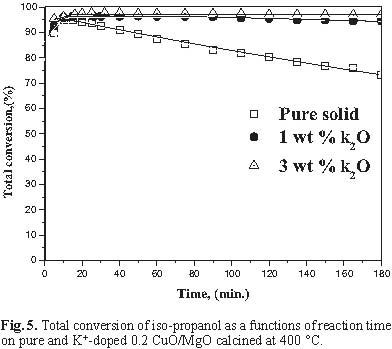
The catalytic activity and selectivity of the investigated solids towards conversion alcohols depend on various parameters such as: (i) the catalyst composition, (ii) calcination temperature (iii) reaction temperature and reusing times as shown in our study. Formation acetone and methyl isopropyl ketone (MIBK ) depends on the presence of (Lewis-acid-strong base) pair [28].
Conclusions
The following are the main conclusions that may be drawn from the obtained results: CuO/MgO system is prepared to be convenient nano-catalytic material calcined at 400-900 °C. Doping CuO/MgO system with 3 mol % K+ calcined at 400°C increases slightly the degree of ordering of MgO phase. The SBET of CuO/ MgO system decreases by K+-doping. The decrease attained 16.5 % due to treatment with 3 mol % K+ for the solids calcined at 400 °C. The catalytic activities have been determined by following the conversion of 2-propanol under certain conditions. This catalytic reaction yielded mainly acetone (major product) besides propene and methyl iso-butyl ketone via aldol condensation with small amounts. The product selectivity depends on the composition of the investigated solids, calcination temperature, and reaction temperature. The catalytic activity of CuO/MgO system calcined at 400 °C increases with increasing the extent of CuO loading up to 28.3 wt % then remained almost constant. Doping with K+ increases not only its catalytic activity but also the catalytic stability and durability of system investigated. The catalytic activity and durability of CuO/MgO solid calcined at 400 °C increases with increasing the amount of K+-added. The doping process increases also the selectivity towards dehydrogenation process.
References
1. Morss, W.-D. Catal. Rev. Sci. Eng. 1983, 25, 591. [ Links ]
2. Dry, M. E., Oosthuizen, G. J. J.Catal. 1968, 11, 18-24. [ Links ]
3. Vebruggen, N. F. D., Mestl, G., Von Hippel, L. M. J., Lengeler, B., Knozinger, H. Langmuir 1994, 10, 3063-3072. [ Links ]
4. Vebruggen, N. F. D., Knozinger, H. Langmuir 1994, 10, 3148-3165. [ Links ]
5. Rombi, E.; Cutrufello, M. G.; Solinas, V.; De Rossi, S.; Ferraris, G.; Pistone, A. Appl. Catal A. 2003, 25, 255-266. [ Links ]
6. Nakamura, J.; Campbell, J. M. ; Campbell, C. T. J. Chem. Soc. Faraday Trans. 1990, 86, 2725-2734. [ Links ]
7. Chen, C-S.; Cheng, W-H.; Lin, S-S. Appl. Catal. A. 2003, 55-67. [ Links ]
8. Miller, G. J.; Rochester, C. H, Waugh, K. C. J. Chem. Soc. Faraday Trans. 1992, 88, 1477-1488. [ Links ]
9. Clarke, D. B.; Bell, A.T. J. Catal. 1995, 154, 314-328. [ Links ]
10. Cornaro, U.; Rossini, S.; Montanari, T.; Finocchio, E.; Busca, G. Catal. Today 2012, 194, 101-108. [ Links ]
11. Gervasini, A.; Carniti,P.; Marzo, M.; Auroux, A. J. Catal. 2012, 296, 143-155. [ Links ]
12. Hur, J.M.; Coh, B.Y.; Lee, H.I. Catal. Today 2000, 63, 189-195. [ Links ]
13. Cordi, E. M.; O' Nill, P.J.; Falcone, J.L. Appl. Catal. B 1997, 14, 23-36. [ Links ]
14. Antoine, A.; Rafeh, B.; Cossi Faustin, A.; Jean Pierre, B.; Abdellah, O. J. Chem. Soc. Faraday Trans. 1993, 89, 2545-2549. [ Links ]
15. Ahmed, A. I. Bull. Soc. Chem. Fr. 1990, 2, 179-183. [ Links ]
16. El-Molla, S.A. Appl. Catal. A 2005, 280, 189-197. [ Links ]
17. Cullity, B.D. "Elements of X-ray Diffraction" 2nd Addison-Wesley Publishing Co, Reading, MA, USA, 1978. [ Links ]
18. El-Molla, S.A. Appl. Catal. A 2006, 298. 103-108. [ Links ]
19. Wojciechowska, M.; Haber, J.; Lomnicki, S.; Stoch, J. J. Mol. Catal. A 1999, 141, 155. [ Links ]
20. Pepe, F.; Angeletti, C. ; Rossi, S.; Lo Jacono, M.; J. Catal. 91, 1985, 69. [ Links ]
21. Henrich, V.E.; Cox, P.A. "The Surface Science of Metal Oxides", University Press, Camberidg, New York 1994, 1-5. [ Links ]
22. Hadden, R.A.; Lambert, P.J.; Ranson, C. Appl. Catal. A 1995, 122, L1-L4. [ Links ]
23. El-Shobaky, G.A.; Fagal, G.A.; Mokhtar, M. Appl. Catal. A 1997, 155, 167-178. [ Links ]
24. Rioux, R.M.; Vannice, M.A. J. Catal. 2003, 216, 362-376. [ Links ]
25. Zaccheria, F.; Ravasio, N.; Fusi, A.; Psaro, A. Tetrahedron Lett. 2005, 46, 3695-3697. [ Links ]
26. Zaccheria, F.; Ravasio, N.; Fusi, A. Chem. Eur. J. 2006, 12, 6426-6431. [ Links ]
27. Salem, A.M.; Mokhtar, M.; El-Shobaky, G.A. Solid State Ionics 2004, 170, 33-42. [ Links ]
28. Dicosimo, J.I.; Diez, V.K.; Iglesia, M.; Xu. E.; Apestegula, C.R. J. Catal. 1998, 178, 499-510. [ Links ]














